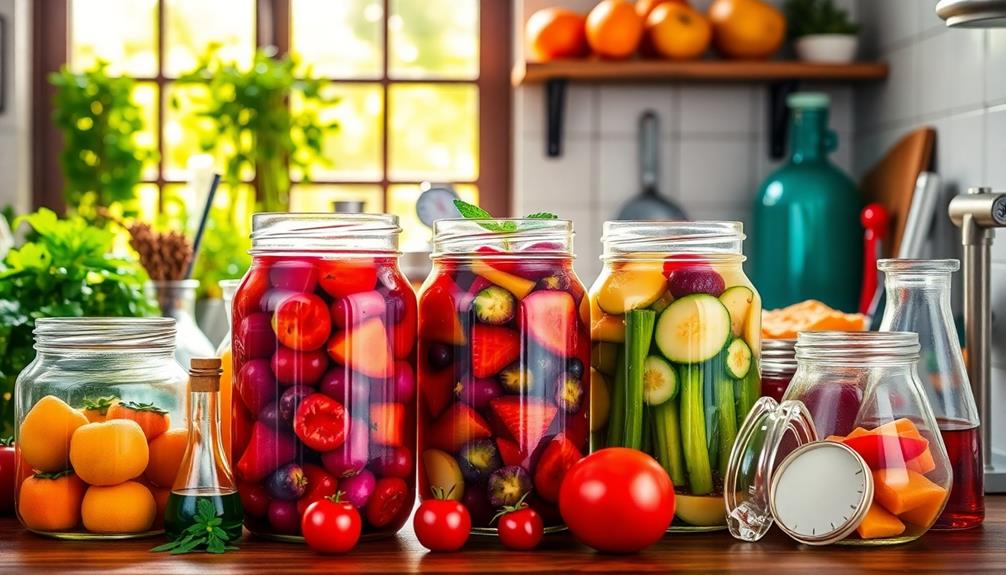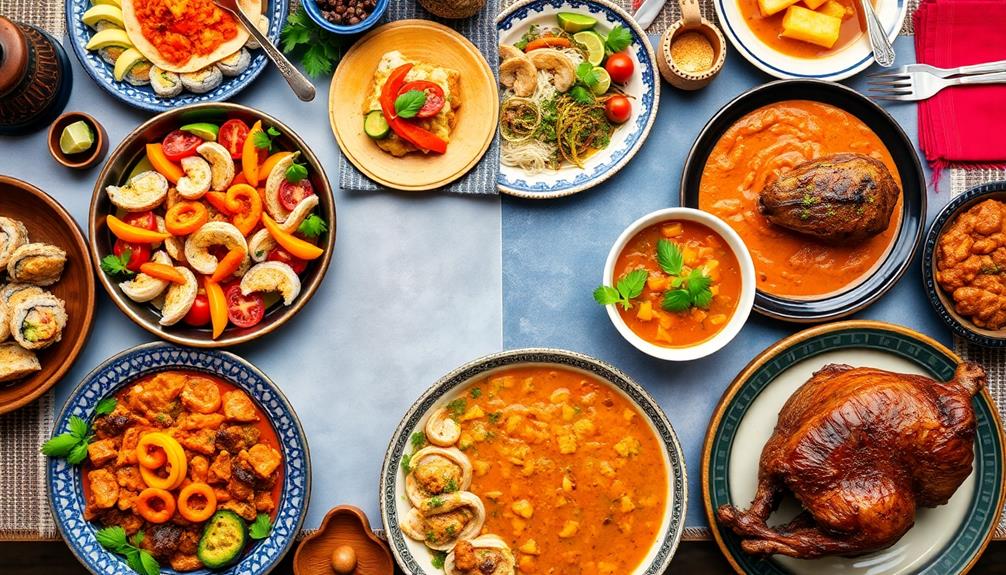The science of perfect food preservation is all about keeping your ingredients fresh and extending their shelf life. You can choose from various techniques like freezing, dehydrating, and canning. Each method has its perks—freezing halts bacterial growth, while dehydrating intensifies flavors by removing moisture. Always pack your foods in airtight containers to avoid freezer burn and maintain quality. Don't forget to label and date your items to guarantee you're enjoying them at their best. Interested in discovering the best methods for your favorite foods? There's a lot more to explore about enhancing your food preservation skills!
Key Takeaways
- Food preservation techniques like canning, freezing, and dehydrating extend shelf life and reduce waste by inhibiting bacterial growth and moisture.
- Freezing at 0°F (-18°C) maintains freshness and prevents spoilage, making it ideal for preserving fruits, vegetables, and meats.
- Dehydration intensifies flavors by removing moisture, using methods such as air drying, sun drying, or electric dehydrators.
- Proper packaging in airtight containers prevents freezer burn and maintains the quality of stored food items.
- Implementing FIFO (first in, first out) ensures older food is used first, minimizing waste and maximizing freshness.
Understanding Food Preservation
Food preservation is crucial for extending the shelf life of perishable items and minimizing waste in your kitchen. Understanding the science behind food preservation techniques like drying, canning, and pickling is essential for anyone interested in home food preservation.
These methods not only help you save money but also guarantee that you maintain the quality and safety of your food. For instance, techniques such as farm-to-table cooking highlight the importance of using fresh, seasonal ingredients which can be preserved for future use.
Dehydration, for instance, removes moisture, which prolongs shelf life while intensifying flavors. You can use this technique on fruits, vegetables, and even meats.
Canning requires careful attention to research-based recipes, considering factors like pH and heat penetration to prevent foodborne illnesses. When you grasp these scientific principles, you can adapt your food storage habits to fit your lifestyle.
Each method offers unique benefits, whether you're looking to enjoy fresh produce year-round or minimize food waste.
Freezing Techniques and Tips
Freezing is one of the most effective methods for preserving food quality while extending shelf life. When freezing foods, make certain to do it at 0°F (-18°C) or lower to halt bacterial growth and maintain freshness for months. Proper packaging is essential; use airtight containers or freezer bags to prevent freezer burn, which can ruin texture and flavor.
For instance, leftover turkey from your Thanksgiving feast can be frozen to use later in a comforting Turkey Soup or a delicious turkey sandwich.
Before freezing vegetables, consider blanching them. This simple process helps retain their color, texture, and nutritional value during storage. Just briefly boil the veggies, then plunge them into ice water before packing them away.
Be mindful of high water content foods like lettuce and cucumbers. They don't freeze well and may turn mushy when thawed. Instead, opt for vegetables that hold up better in the freezer.
Lastly, always label and date your items before freezing. This practice guarantees you use older items first and helps you keep track of how long food has been stored.
Dehydrating Methods Explained
Dehydrating foods is a fantastic way to extend their shelf life while preserving essential nutrients. By removing moisture content, you inhibit the growth of bacteria, mold, and yeast, making your dehydrated ingredients last for months or even years.
There are several methods you can use for this time-tested method, including air drying, sun drying, and electric dehydrators. For instance, traditional Chinese dishes like Red-Braised Pork Belly can benefit from proper preservation techniques, ensuring that flavors remain intact even after long storage. If you opt for an electric dehydrator, you'll benefit from controlled temperature and airflow, ensuring ideal results for your food.
Before dehydrating, remember to blanch fruits and vegetables to maintain their color, flavor, and nutritional value. For meats, proper slicing and marination are key to achieving even drying. When you do this correctly, your dehydrated foods will retain about 90-95% of their nutrients, making them a healthy option for long-term storage or snacking.
Once you've successfully dehydrated your foods, storing them properly is essential. Use airtight containers to prevent moisture reabsorption, keeping food fresh and maintaining that crisp texture and flavor.
With these methods in hand, you're well on your way to mastering food preservation through dehydration.
Comparing Preservation Methods
Preservation techniques play a crucial role in extending the life and quality of our favorite ingredients, each method offering unique advantages. When choosing a preservation method, consider how each affects flavor, texture, and nutrition.
Here's a quick comparison to help you decide:
| Method | Advantages | Best For |
|---|---|---|
| Canning | Long shelf life; preserves nutrients | High-acid foods |
| Freezing | Quick and cost-effective; retains quality | Fruits, vegetables, meats |
| Dehydrating | Concentrates flavors; inhibits bacteria | Fruits, vegetables, meats |
| Pickling | Enhances flavor and texture; easy to store | Vegetables |
| Fermentation | Adds probiotics; complex flavors | Sauerkraut, yogurt |
Canning guarantees your high-acid favorites like tomatoes last through the seasons. Freezing maintains the vibrant colors and nutrients of fresh produce. Dehydrating intensifies flavors and extends shelf life, while pickling gives veggies a tangy twist. Each method has its charm, so pick the one that suits your taste and storage needs!
Safe Storage Practices
When it comes to enjoying your preserved foods, safe storage practices are key to maintaining their quality and preventing spoilage. Start by properly labeling and dating all items before freezing or dehydrating. This helps you use them within their ideal storage time, guaranteeing food preservation and keeping your meals family safe.
Incorporating ingredients like cassava can enhance your meals while making sure they remain fresh for longer.
Use airtight containers or vacuum-sealed bags to protect against freezer burn and moisture damage. This way, you'll preserve the freshness and flavor of your stored foods.
Regularly check and clean your storage areas, including freezers and pantries, to stay organized and monitor for any signs of spoilage or contamination.
Maintaining appropriate temperatures is vital. Set your freezer at 0°F (-18°C) or lower and your refrigerator between 32°F and 40°F (0°C to 4°C) to inhibit bacterial growth.
Additionally, implement the FIFO (first in, first out) method in your food storage practices. This minimizes waste and guarantees you use older items before newer ones, keeping your food fresh and flavorful.
Frequently Asked Questions
What Is the Science of Food Preservation?
Food preservation involves scientific methods that extend the shelf life of perishables. You control factors like temperature and moisture to inhibit spoilage, ensuring food safety and quality while reducing waste and promoting sustainability in your kitchen.
How Do You Preserve Food Perfectly?
Preserving food perfectly is like wrapping a gift; you choose the right method. Freeze meats, dehydrate fruits, can vegetables, or pickle cucumbers. Each technique locks in freshness, ensuring your food stays delicious and safe to eat.
What Is the Most Effective Food Preservation Method?
When you consider the most effective food preservation method, freezing stands out. It maintains flavor, color, and nutrients well. Just make certain your food's at 0°F (-18°C) or lower for best results.
How Did Ancient People Keep Their Food From Rotting?
Ancient people kept their food from rotting by drying, salting, and smoking it. They fermented vegetables and dairy, pickled foods in vinegar, and stored items in cool, dark places, ensuring freshness for longer periods.
Conclusion
In your quest for perfect food preservation, you're not just storing ingredients; you're capturing the essence of each season. Imagine plucking ripe tomatoes at their peak, then savoring their sun-drenched flavor months later. Whether you freeze, dehydrate, or can, each method offers a unique glimpse into nature's bounty. By mastering safe storage practices, you guarantee that every bite bursts with freshness, transforming your pantry into a vibrant tapestry of tastes, ready to inspire your culinary creations.









